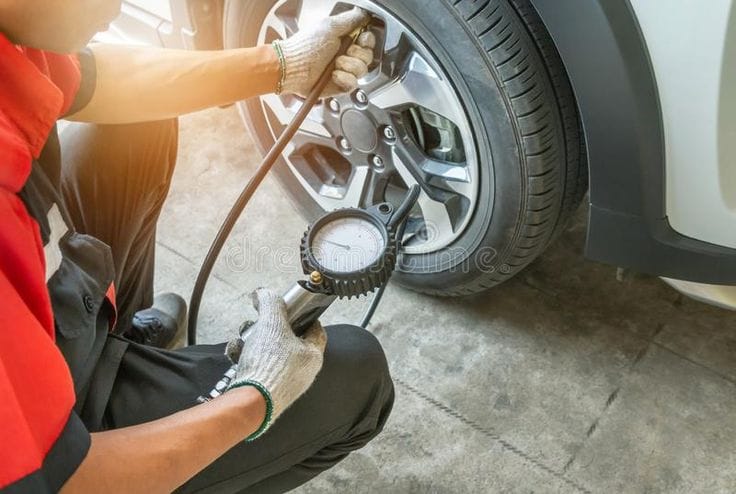7 Warning Signs Your Tyres Need Replacing Before It’s Too Late

7 Warning Signs Your Tyres Need Replacing Before It’s Too Late
Your tyres are the only contact point between your vehicle and the road, yet many drivers overlook critical warning signs until it’s dangerously late. Driving on worn tyres increases your risk of accidents, fines, and costly breakdowns that could have been easily prevented.
How to check if my tyres need replacing isn’t just about avoiding MOT failures – it’s about protecting your family’s safety every time you drive. With the average tyre lasting 20,000-40,000 miles depending on driving conditions, knowing when to act can save you hundreds in emergency repairs and keep you legal on UK roads.
Understanding When to Replace Tyres: The Critical Basics
The legal tyre tread limit in the UK is 1.6mm across the central three-quarters of the tyre width. However, safety experts recommend replacing tyres when tread depth reaches 3mm, especially for wet road tyre safety. At 1.6mm, your stopping distance on wet roads increases by 44% compared to new tyres.
Tyre condition check involves more than just tread depth. Age plays a crucial role – tyres over six years old should be inspected annually by professionals, regardless of tread depth. The rubber compounds deteriorate over time, leading to reduced grip and increased tyre blowout risk.
Most drivers in Croydon and across the UK underestimate how quickly tyres wear. Factors like aggressive braking, cornering, road surfaces, and tyre pressure problems accelerate wear patterns that aren’t always visible to the untrained eye.
The 20p Coin Test: Your Quick Tyre Tread Depth Check
The 20p coin tyre test remains the most accessible method for checking minimum tyre tread depth. Insert a 20p coin into the main tread grooves – if the outer band is visible, your tyre is approaching the legal limit and needs professional assessment.
For more accurate measurements, invest in a tyre tread gauge. These inexpensive tools provide precise readings and help you monitor wear patterns across different areas of the tyre. Professional technicians at Tyre Vortex recommend checking multiple points, as uneven tyre wear often indicates underlying mechanical issues.
Digital tread depth gauges offer the most accuracy, but the 20p test works effectively for quick roadside checks. Remember to check all four tyres, including your spare – many drivers forget that spare tyre check requirements apply to temporary and full-size spares alike.
Visual Inspection: Spotting Dangerous Tyre Damage Symptoms
Tyre sidewall cracks appear as small lines or deeper fissures in the rubber sidewall. These indicate age-related deterioration or damage from kerb impacts. Even minor sidewall damage can lead to sudden tyre failure at high speeds, making replacement essential.
Bulges in tyre walls signal internal structural damage, often caused by impact with potholes or kerbs. These weak spots can rupture without warning, causing dangerous blowouts. Any visible bulge, regardless of size, requires immediate tyre replacement.
Dry rot on tyres manifests as cracking patterns across the tyre surface, particularly in the sidewall areas. This occurs when rubber compounds break down due to age, UV exposure, or chemical contamination. Tyres showing dry rot symptoms should be replaced immediately, even if tread depth appears adequate.
Performance Indicators That Signal Tyre Replacement
Poor handling due to tyres becomes noticeable through reduced steering response, longer braking distances, and decreased cornering stability. If your vehicle feels less stable or responsive than usual, worn tyres might be the culprit affecting your tyre grip loss.
Car pulling to one side often indicates uneven wear patterns caused by alignment issues, but can also signal significantly different tyre conditions between left and right wheels. This symptom requires professional diagnosis to determine if tyre alignment issues or replacement needs are the root cause.
Vibration from tyres through the steering wheel or vehicle body suggests internal tyre damage, uneven wear, or tyre balance check requirements. While balancing might resolve minor vibrations, persistent issues often indicate structural tyre damage requiring replacement.
to get discount check out the site kwiktyre.com
Advanced Warning Signs: What Professionals Look For
Tyre wear indicators are small rubber bars built into the tread grooves. When tread wears down to these indicators, immediate replacement is legally required. However, waiting until wear bars are visible significantly compromises safety and vehicle performance.
Tyre noise problems include increased road noise, squealing during cornering, or unusual sounds during acceleration. These audio cues often precede visible wear signs and indicate degraded tyre performance that affects safety and fuel economy tyres efficiency.
According to automotive safety expert James Richardson, “Modern tyres provide multiple warning systems through visual, tactile, and auditory feedback. Drivers who learn to recognize these early warning signs can prevent 90% of tyre-related incidents.”
Braking distance tyres performance deteriorates gradually, making changes difficult to notice during daily driving. Professional testing shows that tyres at 3mm tread depth require 8 metres additional stopping distance from 70mph compared to new tyres – a crucial safety consideration.
Seasonal and Environmental Factors
Seasonal tyre change considerations vary based on UK weather patterns and driving conditions. Winter tyres should be fitted when temperatures consistently drop below 7°C, while summer tyres perform optimally in warmer conditions.
Temperature fluctuations affect tyre pressure monitoring system readings and can mask gradual pressure loss that accelerates wear. Monthly pressure checks help maintain optimal performance and extend tyre life significantly.
Croydon drivers face unique challenges from urban driving conditions, including frequent stopping, speed bumps, and tight parking spaces that increase front vs rear tyre wear patterns. Regular rotation helps ensure even wear distribution and maximizes tyre investment.
Professional Assessment: When DIY Isn’t Enough
Tyre inspection guide protocols recommend professional assessment when multiple warning signs appear simultaneously. Qualified technicians can identify tyre damage symptoms that aren’t visible during casual inspection, including internal structural damage and irregular wear patterns.
Tyre rotation benefits become apparent through extended tyre life and improved vehicle handling. Professional services like those offered by Tyre Vortex include comprehensive tyre maintenance tips and rotation scheduling that maximizes your tyre investment while maintaining safety standards.
Run-flat tyre signs require specialized knowledge to assess properly. These tyres can appear normal externally while having compromised internal structure following puncture or damage events.
Cost Considerations and Timing
Tyre replacement cost varies significantly based on vehicle type, tyre quality, and replacement timing. Replacing tyres before they reach critical wear levels often proves more economical than emergency replacements or dealing with accident consequences.
Best time to change tyres depends on multiple factors including tread depth, age, seasonal requirements, and driving patterns. Proactive replacement scheduling helps avoid premium pricing during peak demand periods and ensures optimal vehicle safety.
Many Croydon drivers find that mobile tyre fitting in Croydon services provide convenient, cost-effective solutions for busy schedules. [Link to related article on mobile tyre fitting in Croydon]
Taking Action: Your Next Steps
Regular car tyre inspection tips should become part of your monthly vehicle maintenance routine. Check tyre pressure, inspect for visible damage, and monitor wear patterns to catch problems early.
Tyre repair vs replacement decisions should always prioritize safety over cost savings. While minor punctures in the main tread area can often be repaired, sidewall damage, multiple punctures, or significant wear require replacement.
Trust Tyre Vortex for professional tyre assessment and replacement services throughout Croydon and surrounding areas. Our experienced technicians provide comprehensive tyre life check services and honest advice about when replacement becomes necessary for your safety and peace of mind.
Frequently Asked Questions
Q: How often should I check my tyres for wear and damage? A: Monthly tyre inspections are recommended, including pressure checks and visual damage assessment. Before long journeys, always perform a comprehensive tyre safety check covering tread depth, sidewall condition, and proper inflation. Regular monitoring helps identify problems before they become dangerous or expensive.
Q: Can I replace just one tyre, or do I need to replace them in pairs? A: For optimal safety and handling, replace tyres in pairs on the same axle. Significant tread depth differences between tyres can cause handling imbalances and increased wear on the differential. When checking tyres for damage, consider the remaining tyre life on the matching position.
Q: What’s the difference between tyre expiry date and when I should actually replace them? A: Tyre expiry date recommendations suggest replacement after 6-10 years regardless of tread depth, as rubber compounds deteriorate over time. However, actual replacement timing depends on tread depth, visual condition, and performance. Tyres showing tyre puncture signs or structural damage need immediate replacement regardless of age.
Q: How do I know if my tyres are causing my car’s poor fuel economy? A: Under-inflated or worn tyres significantly impact fuel efficiency. Signs include decreased miles per gallon, car pulling to one side, and increased road noise. Properly maintained tyres with adequate tread depth and correct pressure can improve fuel economy by up to 10% compared to worn or under-inflated tyres.
